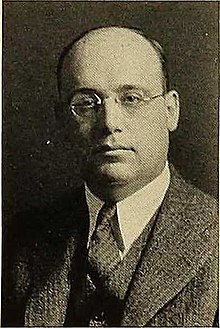Jesse Douglas | |
|---|---|
 Douglas in
c. 1932 | |
| Born | July 3, 1897
New York City,
New York, U.S. |
| Died | September 7, 1965 (aged 68) New York City, New York, U.S. |
| Alma mater |
City College of New York (
BA) Columbia University ( PhD) |
| Known for | Solution to Plateau's problem |
| Spouse |
Jessie Nayler (
m. 1940–1955) |
| Children | Lewis Philip Douglas |
| Awards |
Fields Medal (1936) Bôcher Memorial Prize (1943) |
| Scientific career | |
| Fields | Calculus of variations Differential geometry |
| Institutions |
City College of New York MIT |
| Doctoral advisor | Edward Kasner |
Jesse Douglas (3 July 1897 – 7 September 1965) was an American mathematician and Fields Medalist known for his general solution to Plateau's problem.
Life and career
He was born to a Jewish family [1] in New York City, the son of Sarah (née Kommel) and Louis Douglas. He attended City College of New York as an undergraduate, graduating with honors in Mathematics in 1916. He then moved to Columbia University as a graduate student, obtaining a PhD in mathematics in 1920. [2]
Douglas was one of two winners of the first Fields Medals, [3] awarded in 1936. He was honored for solving, in 1930, the problem of Plateau, which asks whether a minimal surface exists for a given boundary. The problem, open since 1760 when Lagrange raised it, is part of the calculus of variations and is also known as the soap bubble problem. Douglas also made significant contributions to the inverse problem of the calculus of variations. The American Mathematical Society awarded him the Bôcher Memorial Prize in 1943.
Douglas later became a full professor at the City College of New York (CCNY), where he taught until his death. At the time CCNY only offered undergraduate degrees and Professor Douglas taught the advanced calculus course. Sophomores (and freshmen with advanced placement) were privileged to get their introduction to real analysis from a Fields medalist.[ citation needed]
Selected papers
- Douglas, Jesse (1931). "Solution of the problem of Plateau". Trans. Amer. Math. Soc. 33 (1): 263–321. doi: 10.2307/1989472. JSTOR 1989472.
- Douglas, Jesse (1939). "Green's function and the problem of Plateau". American Journal of Mathematics. 61 (3): 545–589. doi: 10.2307/2371314. JSTOR 2371314. PMC 1077111. PMID 16588237.
- Douglas, Jesse (1939). "The most general form of the problem of Plateau". American Journal of Mathematics. 61 (3): 590–608. doi: 10.2307/2371315. JSTOR 2371315. PMC 1077112. PMID 16588238.
- Douglas, Jesse (1939). "Solution of the inverse problem of the calculus of variations". Proceedings of the National Academy of Sciences. 25 (12): 631–637. Bibcode: 1939PNAS...25..631D. doi: 10.1073/pnas.25.12.631. PMC 1077987. PMID 16588312.
- Douglas, Jesse (1940). "A new special form of the linear element of a surface". Trans. Amer. Math. Soc. 48: 101–116. doi: 10.1090/s0002-9947-1940-0002242-2. MR 0002242.
See also
Notes
- ^ Peter Lax, Mathematician: An Illustrated Memoir, by Reuben Hersh (American Mathematical Soc. 2014), page 102
- ^ "Jesse Douglas (1897-1965)". www-history.mcs.st-andrews.ac.uk.
- ^ Colding, Tobias Holck; Minicozzi, William P. "Jesse Douglas (1897–1965): A Biographical Memoir" (PDF). Retrieved 14 January 2024.
References
- Biography in Dictionary of Scientific Biography (New York 1970–1990)
- Biography in Encyclopædia Britannica (Aug. 2003)
Further reading
- Themistocles M. Rassias, The Problem of Plateau – A tribute to Jesse Douglas and Tibor Rado (River Edge, NJ, 1992).
- M. Struwe: Plateau's Problem and the Calculus of Variations, ISBN 0-691-08510-2
- R. Bonnett and A. T. Fomenko: The Plateau Problem (Studies in the Development of Modern Mathematics), ISBN 2-88124-702-4
- M. Giaquinta and S. Hildebrandt: "Calculus of Variations", Volumes I and II, Springer Verlag
- Gray, Jeremy; Micallef, Mario (2008). "The Work Of Jesse Douglas On Minimal Surfaces". Bulletin of the American Mathematical Society. New Series. 45 (2): 293–302. doi: 10.1090/S0273-0979-08-01192-0.
External links
- O'Connor, John J.; Robertson, Edmund F., "Jesse Douglas", MacTutor History of Mathematics Archive, University of St Andrews
- 1897 births
- 1965 deaths
- 20th-century American mathematicians
- City College of New York faculty
- Columbia Graduate School of Arts and Sciences alumni
- Differential geometers
- Fields Medalists
- Institute for Advanced Study visiting scholars
- Jewish American scientists
- Mathematical analysts
- Mathematicians from New York (state)
- Scientists from New York City
- Variational analysts
- Members of the United States National Academy of Sciences